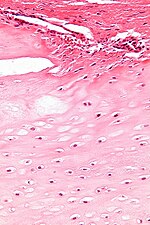Enchondroma
| Enchondroma | |
|---|---|
 |
|
| Micrograph of an enchondroma. H&E stain. | |
| Classification and external resources | |
| ICD-O | 9220/0 |
| DiseasesDB | 33380 |
| eMedicine | article/389224 |
| MeSH | D002812 |
An enchondroma is a cartilage cyst found in the bone marrow. Typically, enchondroma is discovered on an X-ray scan. Enchondromas have a characteristic appearance on Magnetic Resonance Imaging (MRI) as well. They have also been reported to cause increased uptake on PET examination.
Enchondroma is a type of benign bone tumor that originates from cartilage. The exact etiology of it is not known. An enchondroma most often affects the cartilage that lines the inside of the bones. The bones most often involved with this benign tumor are the miniature long bones of the hands and feet. It may, however, also involve other bones such as the femur, humerus, or tibia. While it may affect an individual at any age, it is most common in adulthood. The occurrence between males and females is equal. It is not very likely that the enchondroma will grow back in the same spot; the rate is less than ten percent.
While the exact cause of enchondroma is not known, it is believed to occur either as an overgrowth of the cartilage that lines the ends of the bones, or as a persistent growth of original, embryonic cartilage.
An enchondroma may occur as an individual tumor or several tumors. The conditions that involve multiple lesions include the following:
Ollier disease (enchondromatosis) - when multiple sites in the body develop the tumors. Ollier disease is very rare.
Maffucci's syndrome - a combination of multiple tumors and angiomas (benign tumors made up of blood vessels).
Individuals with an enchondroma often have no symptoms at all. The following are the most common symptoms of an enchondroma. However, each individual may experience symptoms differently. Symptoms may include:
The symptoms of enchondroma may resemble other medical conditions or problems. Always consult your physician for a diagnosis.
Because an individual with an enchondroma has few symptoms, diagnosis is sometimes made during a routine physical examination, or if the presence of the tumor leads to a fracture. In addition to a complete medical history and physical examination, diagnostic procedures for enchondroma may include the following:
...
Wikipedia
